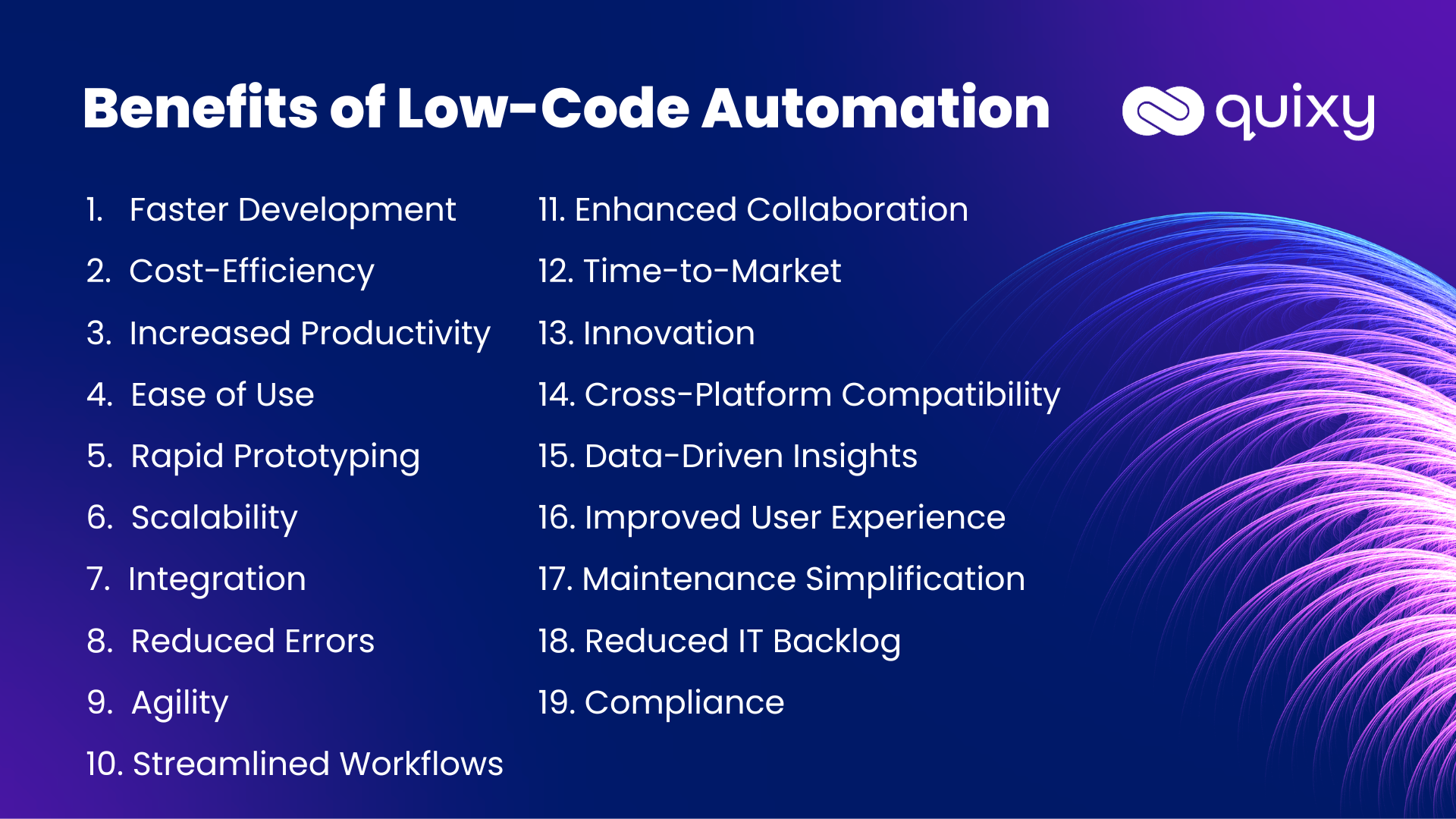
Are you tired of playing catch-up with your competitors in the fast-paced business world? If so, it’s time to explore the revolutionary benefits of low-code automation. As technology advances and customer expectations continue to soar, businesses constantly seek ways to innovate, adapt, and thrive. Low-code automation has emerged as a beacon of hope for enterprises looking to not only keep pace with the ever-evolving market but also to surge ahead.
This article will delve into the numerous benefits of low-code development automation and how it can propel your business ahead of the competition. With the capacity to simplify and expedite your digital transformation journey, low-code automation is more than just a buzzword; it’s a pivotal strategy for staying relevant, efficient, and successful in today’s business landscape.
What is Low-Code Automation?
Before diving into the benefits, let’s first understand low-code automation. Low-code automation is a technology that allows businesses to develop and deploy software applications with minimal hand-coding and manual programming. This approach significantly reduces the time and resources required for traditional software development.
Benefits of Low-Code Automation

Faster Development
One of the most prominent advantages of low-code automation is its ability to expedite the software development process. Traditional coding can be time-consuming and complex. With low-code automation, you can build and deploy applications in a fraction of the time it would take using traditional development methods. This accelerated pace means you can respond to market demands and changes much more swiftly.
Cost-Efficiency
Reducing operational costs is a priority for any business. Low-code automation can help you achieve significant cost savings by streamlining the development process. You’ll require fewer developers and the ones you do employ can be more productive. Also, maintenance, and updates are simplified, leading to further cost reductions.
Also Read: Complete Guide to Workflow Automation Software
Increased Productivity
Low-code automation democratizes the software development process. You don’t need a team of highly specialized coders to create applications. Business analysts, subject matter experts, and citizen developers can actively participate in the development process. This not only broadens the pool of talent available for development but also fosters innovation throughout your organization.
Ease of Use
As the name suggests, LC automation is easy to use. You don’t need extensive coding knowledge to build applications. The visual, drag-and-drop interface simplifies the development process, making it accessible to a broader range of individuals within your organization.
Rapid Prototyping
In a dynamic business environment, rapid prototyping is essential. Low-code automation allows you to quickly create prototypes and test ideas. This is invaluable for validating concepts and ensuring your software aligns with business needs.
Scalability
As your business grows, so do your software needs. Low-code automation allows for scalable development. Whether you need to build a simple app or a complex enterprise-level system, the technology can accommodate your requirements. This flexibility ensures your software can grow with your business.
Integration
In a world of interconnected systems, the ability to integrate with existing software is vital. Low-code platforms offer a range of connectors and APIs that make integration with other tools and systems a breeze. This ensures your applications can work seamlessly with your existing technology stack.
Reduced Errors
Manual coding is prone to errors that can be costly to rectify. Low-code automation, on the other hand, enforces best practices and reduces the chance of errors. Automated testing and validation processes help maintain the quality and reliability of the developed applications.
Also Read: Digital Process Automation – Everything You Need to Know
Agility
In a rapidly changing business landscape, adaptability is crucial. LC automation allows you to modify and enhance your applications as business requirements evolve quickly. This agility ensures you remain competitive and responsive to customer demands.
Streamlined Workflows
Low-code automation streamlines workflows by automating repetitive tasks and processes. This efficiency leads to improved productivity and reduced operational overhead.
Enhanced Collaboration
Collaboration is key in any business environment. Low-code automation fosters collaboration between business and IT teams. Business stakeholders can provide direct input during the development process, leading to applications that precisely meet their needs.
Low-code automation can help you build and deploy applications up to 70% faster compared to traditional coding methods.
Time-to-Market
Reducing time-to-market is a significant advantage in today’s competitive landscape. Low-code automation helps you get your applications to market faster, allowing you to capitalize on opportunities before your competitors.
Innovation
Finally, low-code automation promotes innovation within your organization. It empowers your teams to experiment, test ideas, and create applications that can drive your business forward. It’s a catalyst for continuous improvement and creativity.
Cross-Platform Compatibility
Low-code applications are often compatible with various platforms and devices, ensuring your software can reach a broader audience.
Data-Driven Insights
Low-code platforms often come with built-in analytics and reporting tools, providing valuable data-driven insights for informed decision-making.
Improved User Experience
By allowing business stakeholders to play an active role in development, low-code automation ensures that the resulting applications are user-friendly and aligned with user expectations.
Maintenance Simplification
Low-code applications are easier to maintain and update, reducing the time and resources required for ongoing software management.
Reduced IT Backlog
With business users empowered to create their applications, the IT department can focus on more strategic tasks, reducing the IT backlog.
Also Read: Why Choose Quixy as your Workflow Automation Tool?
Compliance
Security and compliance are paramount in today’s digital age. Low-code platforms often come with built-in security features, making it easier to adhere to industry standards and regulations. Additionally, they simplify auditing and reporting processes.

Action Plan to Low-Code Automation Success
You’re likely eager to explore how low-code automation can transform your own organization. Here are some actionable steps to get you started:
1. Assess Your Needs
The first step is to identify areas within your business that could benefit most from automation. Consider processes that are manual, repetitive, or error-prone. Analyze your current workflows and pinpoint bottlenecks that low-code solutions can address.
2. Explore Low-Code Platforms
Many low-code platforms offer free trials or limited-feature versions. Take advantage of these opportunities to experiment with different platforms and see which one best suits your needs. Consider factors like user interface, available features, integrations, and ease of use.
3. Identify Your Champions
Low-code development doesn’t have to be solely an IT department endeavor. Identify “citizen developers” within your organization – business users with a knack for problem-solving and a basic understanding of technology. Empower them with low-code training resources to become champions of automation within your teams.
4. Start Small and Scale Up
Don’t try to automate everything at once. Begin by focusing on a single, well-defined process. This allows you to learn the ropes of low-code development and experience the benefits firsthand. Once you’ve achieved success with a pilot project, you can gradually scale up and automate more complex workflows.
Calculating ROI of Low-Code Automation
Calculating the exact ROI of low-code automation can vary depending on your specific projects and implementation. However, some factors to consider include:
- Reduced development costs: Estimate the time and resources saved compared to traditional development.
- Increased productivity: Quantify the time saved by automating tasks and improved workflows.
- Improved revenue: Calculate the potential increase in revenue from faster time-to-market or better customer service.
- Reduced errors: Estimate the cost savings associated with fewer errors and higher data accuracy.
By factoring in these elements, you can create a compelling ROI case for implementing low-code automation in your organization.
Conclusion
The advantages of low-code automation are abundant and transformative. This innovative technology is reshaping the modern business landscape, offering accelerated speed and efficiency, cost savings, and improved collaboration. Its flexibility and scalability make it the ideal tool for businesses aiming to stay agile in a dynamic market environment, all while maintaining robust security and compliance standards.
Adopting low-code automation allows your business to flourish in the digital age, surpassing competitors and easily achieving your goals. It’s time to make a strategic move toward the future of software development, where low-code automation reigns supreme. Embrace this game-changing technology, and get ready to witness your business thriving like never before.
As technology continues to evolve, staying competitive demands not just innovation but also adaptability. Low-code automation provides a future-proof solution, ensuring your business can seamlessly integrate emerging technologies and remain at the forefront of industry trends. It’s not just about solving today’s problems; it’s about preparing for the challenges and opportunities of tomorrow. So, if you want your business to be not just successful but future-ready, low-code automation is the key to unlocking sustained growth and relevance in the ever-changing business landscape.
Frequently Asked Questions(FAQs)
Q. How does Low-Code automation streamline processes?
Low-code automation is a technology that simplifies application development by using visual interfaces and pre-built components, reducing the need for traditional coding. It streamlines processes by allowing users to design and deploy applications quickly, making it an ideal solution for automating tasks, workflows, and business processes with minimal manual coding.
Q. What are the low-code automation advantages?
Low-code automation offers various benefits, including increased development speed, reduced costs, enhanced collaboration, and improved productivity. It accelerates application development, enabling your business to adapt rapidly to market changes and maintain a competitive edge while saving resources and promoting efficient teamwork.
Q. Is low-code suitable for businesses of all sizes and industries?
Yes, low-code automation is versatile and suitable for businesses of all sizes and across various industries. It caters to the unique needs of small startups, mid-sized companies, and large enterprises. Its flexibility & scalability make it adaptable to diverse business requirements, from finance and healthcare to manufacturing and retail.
Q. How does low-code ensure security and compliance?
Low-code platforms prioritize security and compliance by providing robust features like authentication, access control, and audit trails. They also support integration with existing security measures. This ensures that your applications built with low-code technology meet necessary security standards and regulatory requirements, protecting sensitive data and maintaining legal compliance.
Q. Can low-code automation future-proof my business?
Yes, low-code automation is a future-proof solution. It allows your business to adapt to emerging technologies and market trends quickly. With its flexibility and ease of modification, you can continuously update and expand your applications, ensuring your business remains relevant and competitive in a rapidly evolving business landscape.
Login
Please login to comment
0 Comments
Oldest















